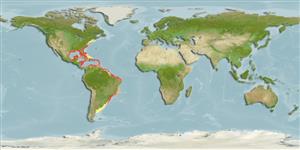Malacostraca |
Decapoda |
Inachidae
Environment: milieu / climate zone / εύρος βάθους / distribution range
Οικολογία
; εύρος βάθους 1 - 366 m (Αναφ. 97531). Tropical; 38°N - 42°S, 102°W - 28°W
Western Atlantic. From North Carolina, the Gulf of Mexico south to Brazil, Uruguay and Argentina. Tropical to subtropical.
Length at first maturity / Μέγεθος / Weight / Age
Γεννητική Ωρίμανση: Lm ? range ? - ? cm Max length : 0.8 cm CW αρσενικό/απροσδιόριστο; (Αναφ. 93549)
Epibiotic (Ref. 97531). Inhabits calcareous algae, corals, rock, shell, and sand bottoms. Occurs together with sponges. From the intertidal zone to great depths (Ref. 104481). Dwells in reef and seagrass habitats in Belize. Forms facultative associations with sea anemones (Ref. 128695).
Life cycle and mating behavior
Γεννητική Ωρίμανση | Αναπαραγωγή | Γεννοβολία | Eggs | Γονιμότητα | Larvae
Members of the order Decapoda are mostly gonochoric. Mating behavior: Precopulatory courtship ritual is common (through olfactory and tactile cues); usually indirect sperm transfer.
Bright, T.J. 2010 A list of species from Glover's Reef Atoll, Belize. Wildlife Conservation Society. http://wcsgloversreef.org/LinkClick.aspx?fileticket=PBNMdMHt15g%3D&tabid=1207&language=en-US [Accessed 22/11/2010]. (Αναφ. 85586)
IUCN Red List Status
(Αναφ. 130435: Version 2025-1)
CITES status (Αναφ. 108899)
Not Evaluated
Not Evaluated
Threat to humans
Human uses
αλιεία: Εμπορικό(ά)
| FishSource |
Εργαλεία
Περισσότερες πληροφορίες
Τροφική ΟικολογίαFood items (preys)Σύσταση δίαιταςΚατανάλωση τροφήςΘηρευτές Population dynamicsΑύξηση
Max. ages / sizes
Length-weight rel.
Length-length rel.
Length-frequencies
Mass conversion
Αφθονία
PhysiologyΚατανάλωση οξυγόνου
Human RelatedStamps, coins, misc.
Διαδικτυακές πηγές
Estimates based on models
Fishing Vulnerability
Low vulnerability (10 of 100).
Price category
Unknown.
